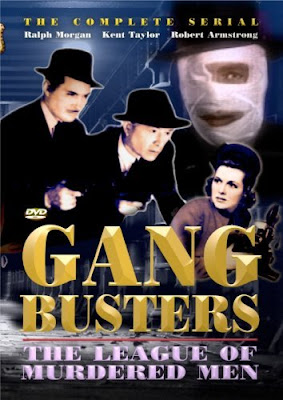PHENOMENALITY: *marvelous*
MYTHICITY: *good*
FRYEAN MYTHOS: *adventure*
CAMPBELLIAN FUNCTION: *metaphysical. psychological*
One might think that rewriting "The Phantom of the Opera" for lucha-wrestlers could only succeed as a "so bad it's good" notion. But no, it's actually a fine little pulp thriller with a delirious sense of pulp-poetry about it. As with many similar films, the poetry would seem to have no real "auteur" behind it. Of the two writers, the appositely named Jesus "Murcielago" Velasquez also contributed to the above-average WORLD OF THE VAMPIRES, while Luis Vergara, also a producer on several Santo and Blue Demon films, is somewhat infamous for his participation in a quartet of cheapjack Boris Karloff films of the late 1960s. Director Federico Curiel directed various other luchadore films, and I've not seen all of them, though so far THE CHAMPIONS OF JUSTICE has been his best outing.
This was the third feature film devoted to the exploits of the masked wrestler Blue Demon, still today the second-best known luchador next to El Santo. If the hero had any ongoing mythology, one wouldn't know it from this film; he's practically a placeholder next to the much richer portrait of his opponent The Bat.
Like the Phantom of the Opera, The Bat (Fernando Oses) is hideously deformed beneath the mask he usually wears, though the Bat's facial scars resulted from a wrestling-accident. Despite the fact that lucha-wrestlers might theoretically practice their professions all their lives while masked, the Bat (which was also his wrestling-cognomen) is hugely traumatized, and the wrestling-world thinks that he went mad in some foreign country. Instead, he's deep beneath some Mexican catacombs near a major city, where he lives with a handful of servants who serve his will. From time to time the mad masked man sends his servants-- particularly the hulking Gerardo (Gerardo Zepeda of PANTHER WOMEN fame)-- out to find other men whom the Bat can wrestle with in his private underground ring. After the villain wins each match, as he always does, he instructs Gerardo to free the victims in the city, though for his own reasons Gerardo always kills the innocents. Oddly, the one time the Bat learns of one such homicide, he punishes Gerardo. "Wrestling is not murder," he opines, finding that the sport itself must be holy since it's mentioned in the Biblical narrative of Jacob and the angel.
So the Bat is not devoted to music as the Phantom is, though he does play a piano to anneal his lonely seclusion. Then he chances to hear the musical stylings of a singer named Marta (Marta Romero), and he sends his men to kidnap her, which immediately rings in a strong likeness to the Phantom. Late in the movie we find out that the Bat keeps a cell-full of female prisoners whom he kidnapped to be his love-objects, and who implicitly are in prison because they wouldn't be his bat-bride. Before that revelation, though, as soon as the villain has Marta in his clutches, he importunes her as if her consent is the only thing that can save his tortured soul. However, at no point does propinquity make the terrified girl more sympathetic to El Murcielago.
For that matter, the Bat is not above trying to persuade his desired bride through occult means. Two separate scenes descant on a mysterious root called "Androma" in the subtitles, though from the folklore surrounding the herb, the plant referenced is the mandrake, which did have "love potion" associations. The Bat talks about using it to brainwash Marta, though he never does so, though he seems obsessed with the plant's root, which is shown to look like a woman's body. During Blue Demon's quest for the missing singer, he finds a fragment of mandrake, and seeks to discover where it came from. This detective thread leads to a very weird scene in which the hero seeks out a weird old witch-woman (Enriqueta Reza). However, though the witch shows Blue Demon some visions in her cauldron, she refuses to reveal where mandrake grows, and the luchador has to find the villain by other means.
SHADOW never stints on the action scenes, and the climactic battle of the Bat and the Demon earns high marks. But the film's highlight is the villain's bizarre fixation on both his physical appearance and on the sport of wrestling-- the one used for seducing women, the other for conquering male opponents. As with SANTO IN THE WAX MUSEUM, the weird psychology of the villain is the main thing that makes this a high-mythicity movie, though the strange allusions to mandrake-mythology provide a pleasing side-effect.






























